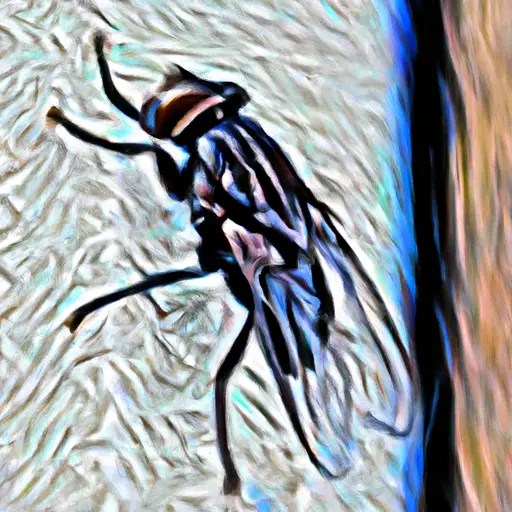How Tall Is Fly? Exploring the Height of Different Species of Flies
Flies are a diverse group of insects that come in a variety of shapes and sizes. Depending on the species, flies can range from just a few millimeters to several centimeters in length. In terms of height, the average fly is usually between 1 and 5 millimeters tall.
The smallest species of fly is the parasitic phorid fly, which measures only 0.4 millimeters in height. These tiny flies are found all over the world and feed on other insects such as ants and bees. The largest species of fly is the giant crane fly, which can reach up to 8 centimeters in length with its wingspan measuring up to 15 centimeters across!
In between these two extremes lies an array of different types of flies that vary greatly in size and shape. Houseflies measure around 4-7 millimeters long while fruit flies are typically 2-3 millimeters long. Horseflies can reach up to 1 centimeter long while hoverflies measure around 3-5 millimeters long with their wingspan reaching up to 7 centimeters across!
No matter what type or size they may be, all flies share certain characteristics such as having two wings, three body parts (head, thorax and abdomen), compound eyes made up of thousands of individual lenses, antennae for sensing their environment and sponging mouthparts for feeding on liquids or soft foods like nectar or pollen grains!
The Science Behind How Tall Flies Can Grow: Examining the Factors That Affect Fly Height
Flies are among the most common insects in the world, and they come in a variety of sizes. While some species of flies may be quite small, others can grow to impressive heights. Understanding how tall flies can grow requires an examination of the factors that affect their height.
The primary factor influencing fly height is genetics. Flies inherit certain traits from their parents, including size and shape. This means that if a fly’s parents were larger than average, then it is likely that their offspring will also be larger than average. Additionally, some species of flies have been selectively bred over time to produce larger individuals with specific characteristics such as increased wing size or body length.
In addition to genetics, environmental factors also play an important role in determining fly height. Temperature is one such factor; warmer temperatures tend to promote faster growth rates in many insect species including flies, resulting in taller individuals overall. Similarly, access to food resources can influence fly growth; when food sources are plentiful and easily accessible for a given population of flies then they tend to reach greater heights than those living under more limited conditions where food is scarce or hard to find.
Finally, age plays an important role in determining how tall a particular fly can become; as with other animals and humans alike, younger individuals tend to be smaller than older ones due to slower growth rates during early stages of development compared with later stages when growth accelerates rapidly before reaching maturity at adulthood.
In conclusion, there are several factors that influence how tall a particular species or individual fly can grow: genetics inherited from its parents; environmental conditions such as temperature and access to food resources; and age all play important roles in this process by either promoting or limiting growth potential depending on the circumstances present at any given time for any given population or individual organism respectively
A Comparison of Average Fly Heights Around the World: What Are the Differences?
The average fly height around the world varies significantly, depending on the region and climate. In general, flies tend to fly higher in warmer climates and lower in colder climates. This is due to the fact that warm air rises, allowing flies to take advantage of thermals and soar higher than they would be able to in cooler temperatures.
In tropical regions such as South America, Africa, and Southeast Asia, flies can reach heights of up to 1 kilometer (3281 feet). This is because these regions are typically hot year-round with little variation in temperature. The warm air allows for strong thermals which allow flies to reach great heights with minimal effort.
In temperate regions such as Europe and North America, average fly heights are much lower than those found in tropical areas. Flies here typically reach heights of only a few hundred meters (984 feet) or less due to the cooler temperatures which make it difficult for them to take advantage of thermals. Additionally, these regions experience seasonal changes which further limit their ability to soar high into the sky.
Finally, arctic regions such as Alaska and northern Canada have some of the lowest average fly heights around the world due to their extreme cold temperatures throughout most of the year. Here, flies rarely exceed a few dozen meters (32 feet) above ground level since they cannot generate enough lift from thermal updrafts at these low temperatures.
Overall, there is a wide range of average fly heights around the world depending on regional climate conditions; however it is clear that tropical areas tend have much higher averages than temperate or arctic ones do due their more consistent warm weather patterns throughout most months out of the year
Q&A
1. How tall is Fly?
Fly is a fictional character, so there is no definitive answer to this question. However, in the original comic book series, Fly was described as being about 5 feet tall.
2. Does Fly grow taller over time?
No, Fly does not grow taller over time. In the original comic book series, he remains at a height of 5 feet throughout the story arcs.
3. Is there any way to make Fly taller?
No, there is no way to make Fly taller in the original comic book series or any other adaptations of his story.

